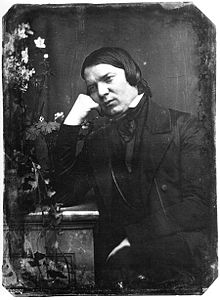Concert piece for four horns (Schumann)
Robert Schumann's concert piece for four horns and large orchestra in F major op. 86 was written in 1849 and premiered in 1850 in the Leipzig Gewandhaus .
Origin, premiere and reception
In 1849 Robert Schumann dealt with the horn as a solo instrument, among other things, and dedicated an “Adagio and Allegro” op. 70 to it before he began composing an orchestral work with four solo horns (in the same year he also wrote “Fünf Gesänge nach Heinrich Laubes Jagdbrevier “for male choir and four horns op. 137). The sketching took place from February 18 to 20, the instrumentation from February 27 to March 11, 1849. Schumann was aware of the unusual line-up, but also of the qualities of the new work, which he himself described as “something very curious” , but also as “one of my best pieces”.
In a private piano performance on October 15, 1849 in the apartment of the horn player Joseph Rudolf Levy, a member of the Dresden court orchestra , the horn player Carl Heinrich Hübler was also involved, who a few years later himself performed a concert piece with this line-up.
On February 25, 1850, Julius Rietz conducted the premiere of the concert piece in the Leipzig Gewandhaus. The four soloists - Eduard Pohle, Joseph Jehnigen, Eduard Julius Leichsenring and Carl Heinrich Conrad Wilcke - were members of the Gewandhaus Orchestra. Schumann then noted a “friendly reception” by the audience. A reviewer of Signals for the Musical World wrote: "As strange as the idea of writing a quadruple concerto for horns must be called, the composition itself is just as peculiar and valuable [...]", however, found the work too long.
The autograph of the concert piece is in the Berlin State Library . After Schumann had unsuccessfully offered his work to several publishers, including Simrock and Breitkopf & Härtel , the Schuberth & Co. publishing house finally took over printing in 1851.
Cast and characterization
In addition to the four horns used as a solo instrument , the score of Schumann's Concert Piece in F major op.86 provides for the following orchestral scoring :
Piccolo flute , 2 flutes , 2 oboes , 2 clarinets , 2 bassoons , 2 horns ad libitum, 2 trumpets , 3 trombones , timpani and strings .
The performance lasts about 18 to 20 minutes. The three movements of the concert piece, which merge directly into one another, have the following performance designations:
- Lively
- Romance. Pretty slow, but not sluggish
- Very lively
The combination of a soloist quartet and an orchestra is unusual in Romanticism and refers on the one hand to the baroque form of the Concerto grosso , on the other hand to the Sinfonia concertante . In fact, in Schumann's concert piece there is less of a direct juxtaposition, rather the two groups often work together in a tonally varied manner.
Schumann recognized the technical possibilities offered by the newly developed valve horn compared to the natural horn and used them purposefully in this work. The 1st horn, which is sometimes played in a very high register, often takes the lead, but in many cases the other three soloists are also involved. The degree of difficulty, especially of the 1st part, meant that sometimes two players were used to master the part.
The first movement follows the sonata form . After two orchestral beats, a motif that begins with fanfare-like triplets , followed by a legato figure, is also the main theme of the movement. A lyrical secondary theme dominates the development.
After only a short pause, the slow, three-part middle movement follows in D minor. The romance theme, intoned by oboe, violas and cellos, is taken over by horns and canonically spun out. The middle section of the movement is in B flat major and is characterized by rich chromatics .
A three-time trumpet signal leads over to the very lively third movement, which is related to the first movement in terms of its motor skills and also thematic design. In the development of the movement, which also follows the sonata form, a reminiscence of the romance theme from the middle movement appears.
Individual evidence
- ↑ This and the following quotations s. Joachim Draheim: Concert works . In: Ulrich Tadday (Ed.): Schumann Handbook. Metzler, Stuttgart / Weimar 2006, ISBN 3-476-01671-4 , pp. 388-389
- ↑ Signals for the musical world, issue 9, 1850, p. 79
- ^ Digitized version of Schumann's op. 86, Berlin State Library
literature
- Joachim Draheim: Concert works . In: Ulrich Tadday (Ed.): Schumann Handbook. Metzler, Stuttgart / Weimar 2006, ISBN 3-476-01671-4 , pp. 388-389.
- Wulf Konold (Ed.): Lexicon Orchestermusik Romantik. S-Z . Piper / Schott, Mainz 1989. ISBN 3-7957-8228-7 , pp. 804-806.
Web links
- Concert piece for four horns, Schumann : sheet music and audio files in the International Music Score Library Project
- Work description by John Palmer at Allmusic (English)
- Work introduction by Irmgard Knechtges-Obrecht, Schumann Portal
- Ernst Herttrich: Foreword piano edition, Henle Urtext 1138, 2012
